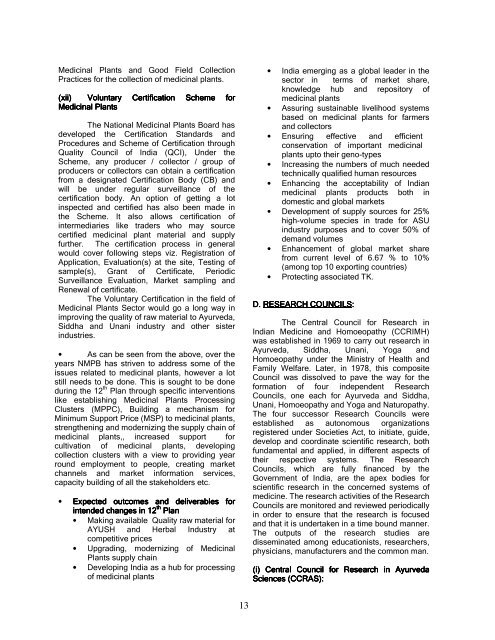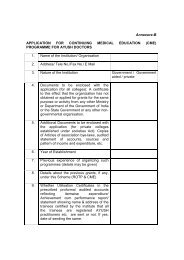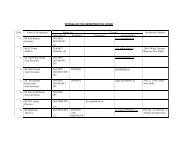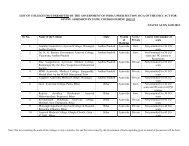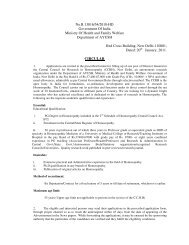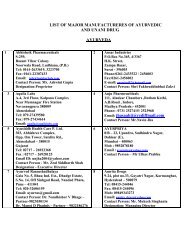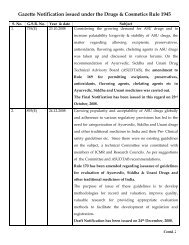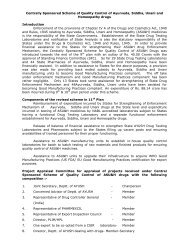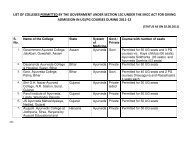INTRODUCTION INTRODUCTION The Indian System of Medicine is ...
INTRODUCTION INTRODUCTION The Indian System of Medicine is ...
INTRODUCTION INTRODUCTION The Indian System of Medicine is ...
You also want an ePaper? Increase the reach of your titles
YUMPU automatically turns print PDFs into web optimized ePapers that Google loves.
Medicinal Plants and Good Field Collection<br />
Practices for the collection <strong>of</strong> medicinal plants.<br />
(xii) Voluntary Certification Scheme for<br />
Medicinal Plants<br />
<strong>The</strong> National Medicinal Plants Board has<br />
developed the Certification Standards and<br />
Procedures and Scheme <strong>of</strong> Certification through<br />
Quality Council <strong>of</strong> India (QCI), Under the<br />
Scheme, any producer / collector / group <strong>of</strong><br />
producers or collectors can obtain a certification<br />
from a designated Certification Body (CB) and<br />
will be under regular surveillance <strong>of</strong> the<br />
certification body. An option <strong>of</strong> getting a lot<br />
inspected and certified has also been made in<br />
the Scheme. It also allows certification <strong>of</strong><br />
intermediaries like traders who may source<br />
certified medicinal plant material and supply<br />
further. <strong>The</strong> certification process in general<br />
would cover following steps viz. Reg<strong>is</strong>tration <strong>of</strong><br />
Application, Evaluation(s) at the site, Testing <strong>of</strong><br />
sample(s), Grant <strong>of</strong> Certificate, Periodic<br />
Surveillance Evaluation, Market sampling and<br />
Renewal <strong>of</strong> certificate.<br />
<strong>The</strong> Voluntary Certification in the field <strong>of</strong><br />
Medicinal Plants Sector would go a long way in<br />
improving the quality <strong>of</strong> raw material to Ayurveda,<br />
Siddha and Unani industry and other s<strong>is</strong>ter<br />
industries.<br />
• As can be seen from the above, over the<br />
years NMPB has striven to address some <strong>of</strong> the<br />
<strong>is</strong>sues related to medicinal plants, however a lot<br />
still needs to be done. Th<strong>is</strong> <strong>is</strong> sought to be done<br />
during the 12 th Plan through specific interventions<br />
like establ<strong>is</strong>hing Medicinal Plants Processing<br />
Clusters (MPPC), Building a mechan<strong>is</strong>m for<br />
Minimum Support Price (MSP) to medicinal plants,<br />
strengthening and modernizing the supply chain <strong>of</strong><br />
medicinal plants,, increased support for<br />
cultivation <strong>of</strong> medicinal plants, developing<br />
collection clusters with a view to providing year<br />
round employment to people, creating market<br />
channels and market information services,<br />
capacity building <strong>of</strong> all the stakeholders etc.<br />
• Expected outcomes and deliverables for<br />
intended changes in 12 th Plan<br />
• Making available Quality raw material for<br />
AYUSH and Herbal Industry at<br />
competitive prices<br />
• Upgrading, modernizing <strong>of</strong> Medicinal<br />
Plants supply chain<br />
• Developing India as a hub for processing<br />
<strong>of</strong> medicinal plants<br />
• India emerging as a global leader in the<br />
sector in terms <strong>of</strong> market share,<br />
knowledge hub and repository <strong>of</strong><br />
medicinal plants<br />
• Assuring sustainable livelihood systems<br />
based on medicinal plants for farmers<br />
and collectors<br />
• Ensuring effective and efficient<br />
conservation <strong>of</strong> important medicinal<br />
plants upto their geno-types<br />
• Increasing the numbers <strong>of</strong> much needed<br />
technically qualified human resources<br />
• Enhancing the acceptability <strong>of</strong> <strong>Indian</strong><br />
medicinal plants products both in<br />
domestic and global markets<br />
• Development <strong>of</strong> supply sources for 25%<br />
high-volume species in trade for ASU<br />
industry purposes and to cover 50% <strong>of</strong><br />
demand volumes<br />
• Enhancement <strong>of</strong> global market share<br />
from current level <strong>of</strong> 6.67 % to 10%<br />
(among top 10 exporting countries)<br />
• Protecting associated TK.<br />
D. RESEARCH COUNCILS:<br />
<strong>The</strong> Central Council for Research in<br />
<strong>Indian</strong> <strong>Medicine</strong> and Homoeopathy (CCRIMH)<br />
was establ<strong>is</strong>hed in 1969 to carry out research in<br />
Ayurveda, Siddha, Unani, Yoga and<br />
Homoeopathy under the Min<strong>is</strong>try <strong>of</strong> Health and<br />
Family Welfare. Later, in 1978, th<strong>is</strong> composite<br />
Council was d<strong>is</strong>solved to pave the way for the<br />
formation <strong>of</strong> four independent Research<br />
Councils, one each for Ayurveda and Siddha,<br />
Unani, Homoeopathy and Yoga and Naturopathy.<br />
<strong>The</strong> four successor Research Councils were<br />
establ<strong>is</strong>hed as autonomous organizations<br />
reg<strong>is</strong>tered under Societies Act, to initiate, guide,<br />
develop and coordinate scientific research, both<br />
fundamental and applied, in different aspects <strong>of</strong><br />
their respective systems. <strong>The</strong> Research<br />
Councils, which are fully financed by the<br />
Government <strong>of</strong> India, are the apex bodies for<br />
scientific research in the concerned systems <strong>of</strong><br />
medicine. <strong>The</strong> research activities <strong>of</strong> the Research<br />
Councils are monitored and reviewed periodically<br />
in order to ensure that the research <strong>is</strong> focused<br />
and that it <strong>is</strong> undertaken in a time bound manner.<br />
<strong>The</strong> outputs <strong>of</strong> the research studies are<br />
d<strong>is</strong>seminated among education<strong>is</strong>ts, researchers,<br />
physicians, manufacturers and the common man.<br />
(i) Central Council for Research in Ayurveda<br />
Sciences (CCRAS):<br />
13


